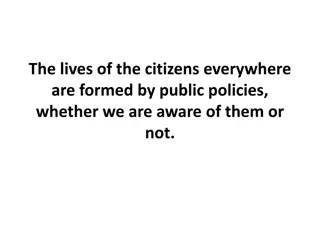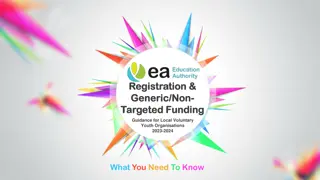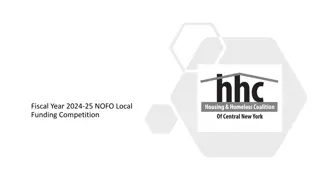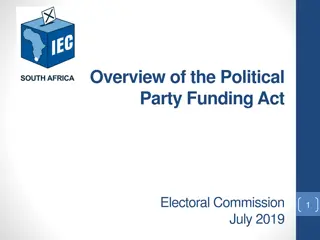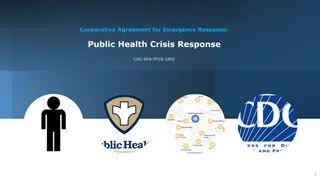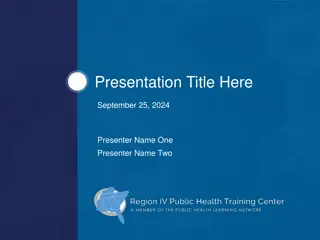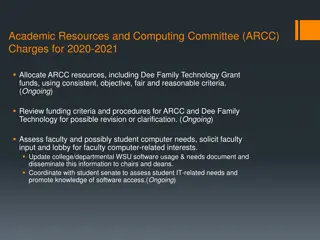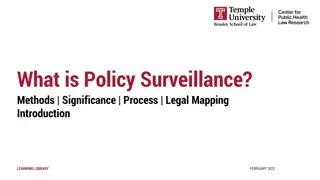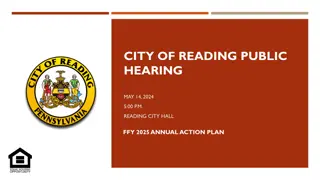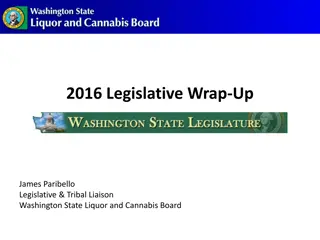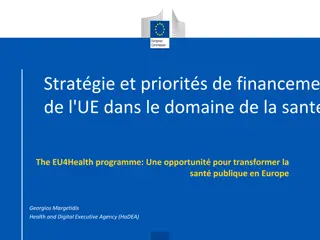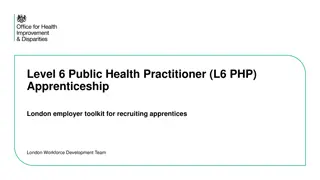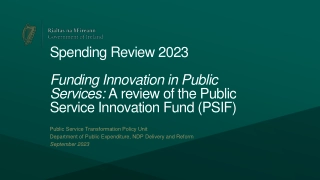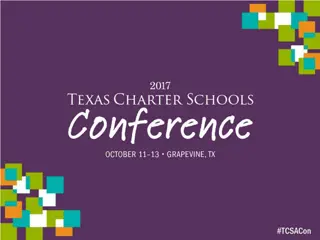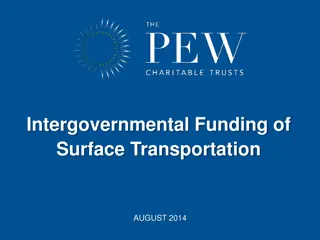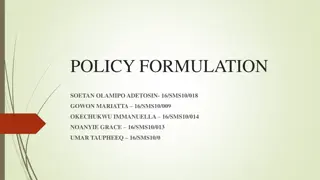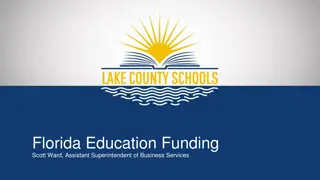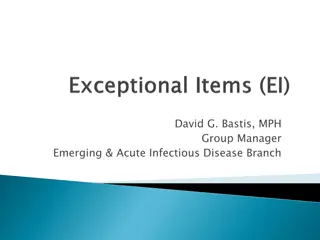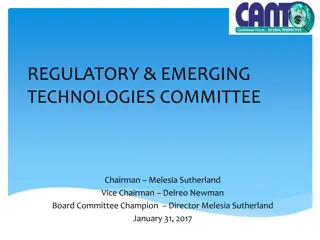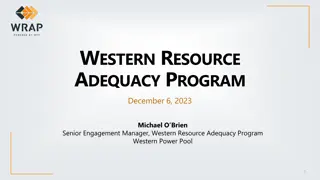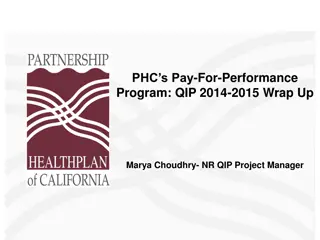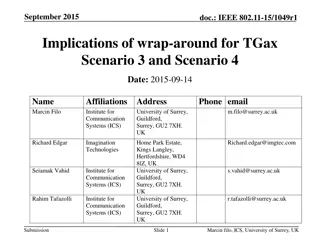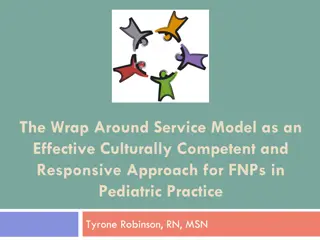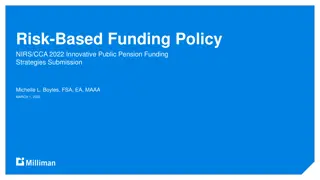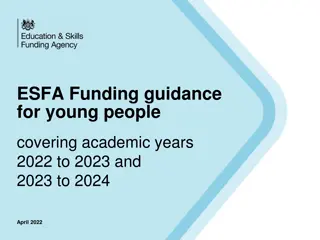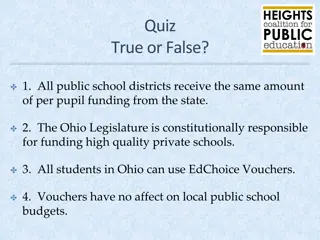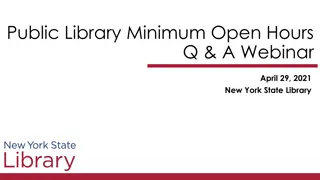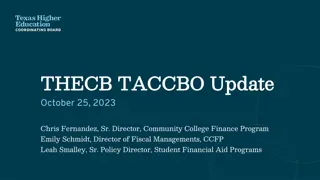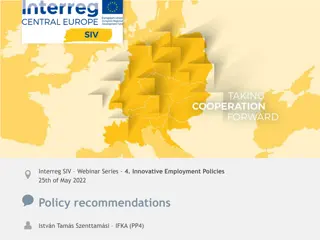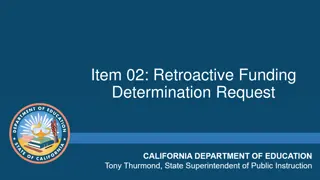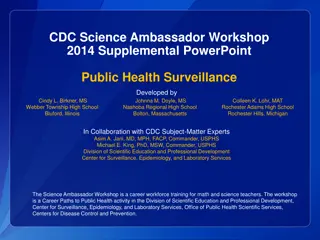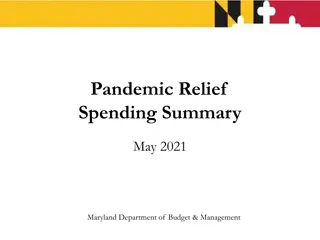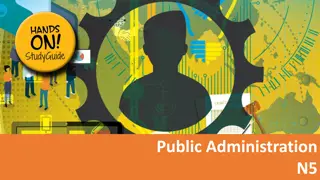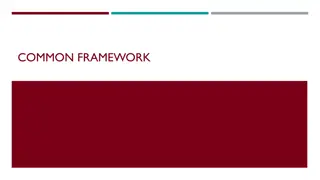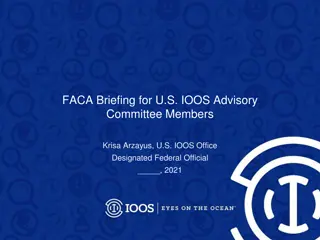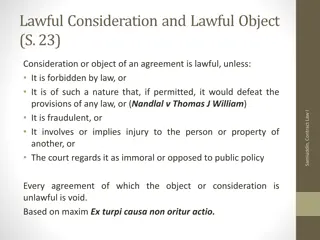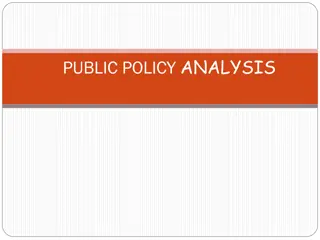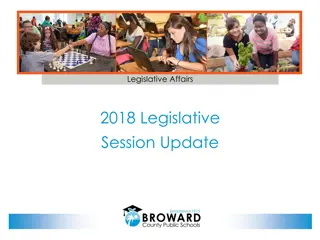Public Health Funding and Policy Committee Wrap-Up June 9, 2021
The session wrap-up covered legislative statistics, budget highlights, DSHS statistics, and the 2022-2023 biennial budget in detail. Key points included the number of bills filed, passed, and signed into law, as well as budget allocations across different goals. The session provided insights into public health funding and policy decisions.
Download Presentation

Please find below an Image/Link to download the presentation.
The content on the website is provided AS IS for your information and personal use only. It may not be sold, licensed, or shared on other websites without obtaining consent from the author. Download presentation by click this link. If you encounter any issues during the download, it is possible that the publisher has removed the file from their server.
E N D
Presentation Transcript
Session Wrap-up Public Health Funding and Policy Committee June 9, 2021 T. Jordan Hill Director, DSHS Government Affairs
Outline Legislative Statistics Budget Highlights Bills of Note Pandemic Response Bills 3
Legislative Statistics 7,148 Bills Filed 1,081 Bills Passed 341 bills signed into law as of 6/7/2021 Veto period: ends June 20th Bills that aren't signed or vetoed by June 20th become law 1 bill vetoed as of 6/7/2021 5
DSHS Statistics 672 filed bills assigned for analysis/monitored 49 assigned bills passed *as of 6/7/2021 17 bills signed into law *as of 6/7/2021 Veto period: ends June 20th 6
2022-2023 Biennial Budget: All Funds by Goal Goal C: Consumer Protection Services 5% Goal D: Agency Information Technology Projects 2% Goal E: Indirect Administration 4% Goal B: Community Health Services 20% Goal A: Preparedness & Prevention Services 69% Total = $1.9 Billion 8
2022-2023 Biennial Budget: General Revenue by Goal Goal C: Consumer Protection Services 9% Goal D: Agency Information Technology Projects 3% Goal E: Indirect Administration 6% Goal B: Community Health Services 35% Goal A: Preparedness & Prevention Services 47% Total = $850.5M 9
2022-2023 Biennial Budget: FTEs by Goal Goal B: Community Health Services 17% Goal C: Consumer Protection Services 17% Goal E: Indirect Administration 6% Goal A: Preparedness & Prevention Services 60% Total = 3,318.9 FTEs *Goal D does not have FTEs 10
Exceptional Items Biennial Amount Conference Committee EI Name FTEs (in Mil.) $36.33; Rider states Insurance addition not allowed 1 - HIV Medications $83.40 1 - HIV Contracts $20.00 2 - Rural Clinics- 14 $8.40 30 Not Adopted 2 - Mobile Clinics- 3 $4.60 6 Not Adopted 3 - Food Safety 25 FTEs $5.90 25 $2.9M 13 FTEs 3 - Hemp 3.4 FTEs $0.60 3.4 see rider 27 3 - RAS Licensing and Registration System $1.20 1 Adopted in HB2 4 - Contract and Fiscal Management 25 FTEs $7.60 25 Not Adopted 4 - Data Center Services $19.90 Adopted in HB2 4 - Health Registries $5.40 1 Not Adopted Total $156.90 91.4 11
Rider and Technical Adjustments Items Conference Committee Vital Statistics 10 FTEs Adopted TCID Capital Authority $880K Adopted Restore funding from 5% reduction to EMS EI Adopted $406K Transfer 10 FTEs SASH to TCID Security Adopted Transfer from HHSC CAPPS $915K Adopted System-related items at HHSC Adopted $632K Reduce General Revenue-Dedicated Account No. 524 (rider 7) Adopted Maternal Mortality adjust Federal Funds to All Funds (rider 22) Adopted 12
Rider and Technical Adjustments Items Conference Committee Hemp 3.4 FTEs with Revenue Collections (rider 27) Adopted Emergency Medical Task Force, and $5M in General Revenue. Additional money for current activity, management functions and equipment (rider 28) Adopted $5M Federal Funds Reporting Requirement on Public Health Emergency Preparedness, Bioterrorism and Immunization (rider 29) Adopted Notification if DSHS expends HIV Care Formula Grants in excess of the appropriated amount (rider 30) Adopted as amended Report on Federal Public Health Funding to Local Health Entities (rider 32) Adopted Report on COVID-10 Immunization Distribution Equity (rider 33) Adopted Texas Center for Nursing Workforce Studies Funding Unexpended Balance Authority (rider 34) Adopted Alzheimer's Disease Program (rider 35) Adopted $1M 13
Contingency Rider Items Conference Committee Sec. 18.09 (HB 1033) - Prescription Drug Price Disclosure $1.3M and 3.7 FTEs Sec. 18.34 (SB 73) - Providing access to Local Public Health Entities and Certain Health Service Regional Offices under Medicaid Final Version removes DSHS $347K of this $245K is capital Sec. 18.46 (SB 968) - Public Health Disaster and Public Health Emergency Preparedness and Response; providing a civil penalty Adopted Sec. 18.47 (SB 969) - Reporting procedures for and information concerning Public Health Disasters Adopted Sec. 18.48 (SB 984) - Public Health Disaster and Public Health Emergency Preparedness and Response Adopted Reduced $704K and 20.6 FTE's in FY23 Sec. 18.51 (HB 133) - Children and Pregnant Women Case Management 14
Unfunded Bills Items Biennial Impact HB 1011 - Expedited death certificates for religious purposes in certain counties. $1.2M and 7 FTEs SB 184 - Reports on the prevalence of eating disorders and eating disorder-related deaths in this state. $38K SB 475 - State agency and local government information security, including establishment of the state risk and authorization management program and the Texas volunteer incident response team; authorizing fees. $270K SB 799 - Contracting procedures and requirements for governmental entities $504K 15
DSHS Bills of Note Prescription Drug Price Disclosure HB 1033 Transfers program to DSHS (from HHSC); requires a fee for reporting process to sustain program; and provides for enforcement mechanism. Reporting required for annual cost and certain price increases within the calendar year. Compassionate Use Program HB 1535 Raises level of allowable THC to 1.0% Expands applicable conditions to include post-traumatic stress disorder Additional conditions allowed if affiliated with an Institutional Review Board process DSHS directed to establish rules by December 1, 2021 Enhancing Levels of Care HB 1164 Requires placenta accreta care-related protocols to be incorporated into maternal levels of care facility designation process PHFPC composition & duties HB 1453/SB 870 (did not pass) Would have increased total members to 10, with one member from TFBHO, and required to meet jointly with the TFBHO at least once annually Terms would have been limited to 3 or 4 years for members and 2 years for presiding officer Committee duties would have been clarified pertaining to scope Formal recommendations would have been due even numbered years 17
Highlights of Pandemic Bills SB 437 PPE reserve advisory committee (TDEM lead) SB 464 Reporting on deaths from reportable diseases to county health authorities and LHDs SB 930 Reporting occurrence of communicable diseases in residential facilities* SB 966 Defining Public Health Disasters/Public Health Emergencies, legislative oversight of PHDs SB 967 Length of local public health orders (15 days) SB 968 Defining PHDs/PHEs, legislative oversight of PHDs, collaboration with TF on Infectious Disease during PHDs and PHEs, COVID response study* SB 969 COVID-related data bill (e.g. additional collection/reporting duties during a public health disaster) SB 984 Adds Epidemiologist to TF on Infectious Disease, requires annual meetings hospital data collection at RAC level outside a pandemic SB 1780 Texas Epidemic Public Health Institute established * Signed by the Governor 19
Powers/Functions Addressed Primary bills involved: SB 966/968/969/984 Requires legislative oversight for renewing public health disasters Defines public health emergencies for future response needs for more limited, isolated, or emerging situations Requires legislative collaboration during public health disasters and emergencies Requires collaboration with the Task Force on Infectious Disease Preparedness & Response during public health disasters and public health emergencies Codifies the Office of the Chief State Epidemiologist Requires lab/hospital reporting during a public health disaster with related public compliance reporting by DSHS Requires hospital reporting to regional advisory councils including non-disaster situations 20
Review/Reports/Studies Review/Study Sources SB 966/968/969/Rider 33 COVID-19 Response Review: by the Preparedness Coordinating Council/State Emergency Management Council Study of DSHS Regions: in collaboration with the Public Health Funding and Policy Committee and other stakeholders Study of Healthcare System Planning and Response Capabilities: in collaboration with HHSC and other stakeholders Study of Data Standardization: in collaboration with the Public Health Funding and Policy Committee and other stakeholders COVID Immunizations Equity Report: regarding access and distribution 21
Effective Dates SB 966/968: will be effective immediately once the Governor signs/chooses not to veto by the end of the veto period (June 20), with important notes: COVID-response report pushed to September 1, 2023 or 9 months following termination of public health disaster, whichever is earlier SB 969: effective September 1, 2021, with important notes: 3 Studies have September 1, 2022 due dates Lab compliance reporting: limited to public health disasters but would be effective 9/1/2021 if a public health disaster is in effect Hospitals/labs required to report via electronic format requirement: kicks in for disasters occurring after January 1, 2023 22
How do they work? Public Health Emergencies: Definition: Determination by the commissioner that there exists an immediate threat from a communicable disease, health condition, or chemical, biological, radiological, or electromagnetic exposure that: Potentially poses a risk of death or severe illness or harm to the public; and Potentially creates a substantial risk of harmful exposure to the public Public Health Disasters: Definition: Declaration by the governor of a state of disaster + Determination by the commissioner that there exists an immediate threat from a communicable disease, health condition, or chemical, biological, radiological, or electromagnetic exposure that: Poses a high risk of death or serious harm to the public Creates a substantial risk of harmful public exposure 23
How do they work? Public Health Emergencies: Duration: 30 days, renewable Renewal: Can be issued/renewed without legislative oversight Actions: legislative collaboration within 7 days + TFID collaboration Public Health Disasters: Duration: 30 days, renewable upon approval Renewal: Must be renewed with approval of lege oversight Actions: legislative collab within 7 days + TFID collaboration Other: requires data collection and related hospital/lab compliance reporting out on DSHS website to be in effect 24



